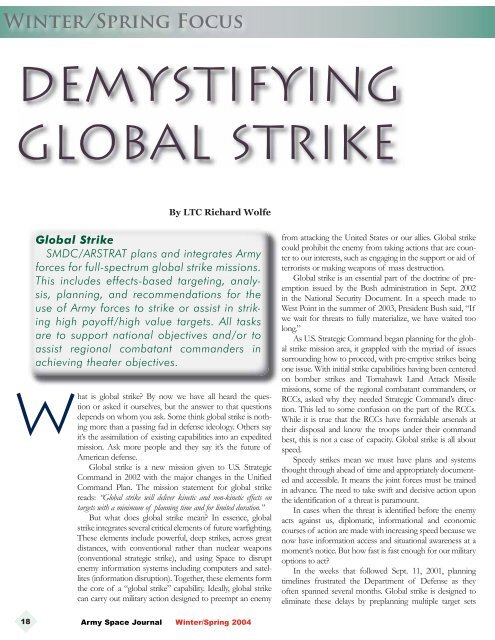Volume 3, Number 1 - Space and Missile Defense Command - U.S. ...
Volume 3, Number 1 - Space and Missile Defense Command - U.S. ...
Volume 3, Number 1 - Space and Missile Defense Command - U.S. ...
You also want an ePaper? Increase the reach of your titles
YUMPU automatically turns print PDFs into web optimized ePapers that Google loves.
Demystifying<br />
Global Strike<br />
By LTC Richard Wolfe<br />
What is global strike? By now we have all heard the question<br />
or asked it ourselves, but the answer to that questions<br />
depends on whom you ask. Some think global strike is nothing<br />
more than a passing fad in defense ideology. Others say<br />
it’s the assimilation of existing capabilities into an expedited<br />
mission. Ask more people <strong>and</strong> they say it’s the future of<br />
American defense.<br />
Global strike is a new mission given to U.S. Strategic<br />
Comm<strong>and</strong> in 2002 with the major changes in the Unified<br />
Comm<strong>and</strong> Plan. The mission statement for global strike<br />
reads: “Global strike will deliver kinetic <strong>and</strong> non-kinetic effects on<br />
targets with a minimum of planning time <strong>and</strong> for limited duration.”<br />
But what does global strike mean? In essence, global<br />
strike integrates several critical elements of future warfighting.<br />
These elements include powerful, deep strikes, across great<br />
distances, with conventional rather than nuclear weapons<br />
(conventional strategic strike), <strong>and</strong> using <strong>Space</strong> to disrupt<br />
enemy information systems including computers <strong>and</strong> satellites<br />
(information disruption). Together, these elements form<br />
the core of a “global strike” capability. Ideally, global strike<br />
can carry out military action designed to preempt an enemy<br />
from attacking the United States or our allies. Global strike<br />
could prohibit the enemy from taking actions that are counter<br />
to our interests, such as engaging in the support or aid of<br />
terrorists or making weapons of mass destruction.<br />
Global strike is an essential part of the doctrine of preemption<br />
issued by the Bush administration in Sept. 2002<br />
in the National Security Document. In a speech made to<br />
West Point in the summer of 2003, President Bush said, “If<br />
we wait for threats to fully materialize, we have waited too<br />
long.”<br />
As U.S. Strategic Comm<strong>and</strong> began planning for the global<br />
strike mission area, it grappled with the myriad of issues<br />
surrounding how to proceed, with pre-emptive strikes being<br />
one issue. With initial strike capabilities having been centered<br />
on bomber strikes <strong>and</strong> Tomahawk L<strong>and</strong> Attack <strong>Missile</strong><br />
missions, some of the regional combatant comm<strong>and</strong>ers, or<br />
RCCs, asked why they needed Strategic Comm<strong>and</strong>’s direction.<br />
This led to some confusion on the part of the RCCs.<br />
While it is true that the RCCs have formidable arsenals at<br />
their disposal <strong>and</strong> know the troops under their comm<strong>and</strong><br />
best, this is not a case of capacity. Global strike is all about<br />
speed.<br />
Speedy strikes mean we must have plans <strong>and</strong> systems<br />
thought through ahead of time <strong>and</strong> appropriately documented<br />
<strong>and</strong> accessible. It means the joint forces must be trained<br />
in advance. The need to take swift <strong>and</strong> decisive action upon<br />
the identification of a threat is paramount.<br />
In cases when the threat is identified before the enemy<br />
acts against us, diplomatic, informational <strong>and</strong> economic<br />
courses of action are made with increasing speed because we<br />
now have information access <strong>and</strong> situational awareness at a<br />
moment’s notice. But how fast is fast enough for our military<br />
options to act?<br />
In the weeks that followed Sept. 11, 2001, planning<br />
timelines frustrated the Department of <strong>Defense</strong> as they<br />
often spanned several months. Global strike is designed to<br />
eliminate these delays by preplanning multiple target sets<br />
18<br />
Army <strong>Space</strong> Journal Winter/Spring 2004

















